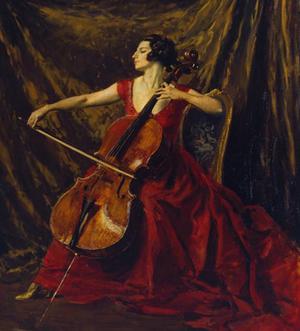Guilhermina Suggia

Guilhermina Augusta Xavier de Medim Suggia Carteado Mena, known as Guilhermina Suggia, (27 June 1885 – 30 July 1950) was a Portuguese cellist. She studied in Paris, France with Pablo Casals, and built an international reputation. She spent many years living in the United Kingdom, where she was particularly celebrated. She retired in 1939, but emerged from retirement to give concerts in Britain. Her last was in 1949, the year before her death.
Suggia bequeathed her instrument to be sold to fund the Suggia Gift, an important British scholarship for young cellists.
Biography
Suggia was born in Porto to a family of Portuguese and Italian descent. Her father was a competent musician and taught her musical theory and cello. Such was her progress that by the age of 12 she was appointed principal cellist of the local orchestra, the Orpheon Portuense.[1][2] In 1904, under the patronage of Queen Maria Amélia of Portugal, she went to study at Leipzig under Julius Klengel. Although Klengel was a professor at the Leipzig Conservatoire, Suggia did not enroll there but rather took private lessons from him[3][4]
Within a year Suggia was asked to appear as a soloist with the
During the period of her residence in Britain during the 1920s and 1930s,[3] she was a frequent visitor to Lindisfarne Castle in northern England, where a cello now rests in the Music Room in commemoration of her time spent there.[8] Her "Montagnana" cello rests in Conservatório de Música do Porto, her home-town in Portugal.
Edward Hudson,the founder of the British magazine Country Life is said to have been infatuated by Guilhermina. He was briefly engaged to her and bought her the aforementioned Montagnana cello and which she is shown playing in the portrait by Augustus John referred to below.[citation needed]
In 1927, Suggia married Jose Mena, an X-ray specialist. During World War II, Suggia and her husband returned to Portugal, where she lived in retirement.[3] She visited Britain after the war, giving performances of the Elgar Cello Concerto in aid of charity.[5] She gave her last concerts at the Edinburgh Festival in 1949 and in Bournemouth later the same year.[5]
Suggia died of cancer in Porto at the age of 65, a year after the death of her husband.[3]
Recordings
Suggia made a small number of gramophone recordings. They include Haydn's D major Concerto with John Barbirolli and Saint-Saëns's A minor Concerto with Lawrence Collingwood.[2] They were reissued on compact disc in 1989 (EMI EH761083-1).[9] A compilation CD was released in 2004 with performances of Haydn, Max Bruch and Lalo (Dutton CDBP9748).[10]
Legacy
Suggia bequeathed her
The large auditorium at Casa da Música in Porto is named Sala Suggia in her honour.[13]
Probably the most famous image of Suggia is the oil portrait by the Welsh artist
See also
References
- ^ The Manchester Guardian, 1 August 1950, p. 5
- ^ a b c d e Anderson, Robert, "Suggia, Guilhermina," Grove Music Online, Oxford Music Online, accessed 26 January 2011 (subscription required)
- ^ a b c d e Obituary, The Musical Times, September 1950, p. 362
- ^ Marques, Virgílio (2018). "Notas biográficas". Hemeroteca Municipal de Lisboa. Retrieved 25 April 2021.
- ^ a b c Obituary, The Times, 1 August 1950, p. 6
- OCLC 994220809.
- ^ Suggia, Guilhermina, "The Violoncello", Music & Letters", April 1920, p. 107
- ^ "Guilhermina Suggia" Archived 4 March 2012 at the Wayback Machine, Musicians' Benevolent Fund, accessed 27 January 2011
- ^ Sanders, Alan, "Cello Recital", Archived 5 November 2011 at the Wayback Machine Gramophone, February 1989, p. 96
- ^ Guilhermina Suggia Plays Haydn, Bruch & Lalo Dutton CDBP9748
- ISBN 0-306-80976-1.
- ^ "Guilhermina Suggia Gift" Archived 29 October 2010 at the Wayback Machine, Musicians' Benevolent Fund, accessed 27 January 2011
- ^ Casa da Musica Room by Room Archived 21 January 2011 at the Wayback Machine
- ^ George Eastman House Fotoarchiv
- ^ National Portrait Gallery
Further reading
- Mercier, Anita (2008). Guilhermina Suggia: Cellist. Ashgate, ISBN 978-0-7546-6169-6
- Guilhermina Suggia ou o violoncello luxuriante. Or the Luxuriant Violoncello, Fátima Pombo, Fundação Eng. António de Almeida, Porto (1993). This book is in both Portuguese and in English. ISBN 972-9194-54-8
- la Suggia : l'autre violoncelliste, Henri Gourdin, Editions de Paris – Max Chaleil, Paris (2015). ISBN 978-2-84621-210-6
